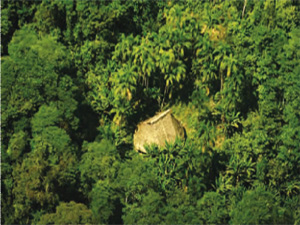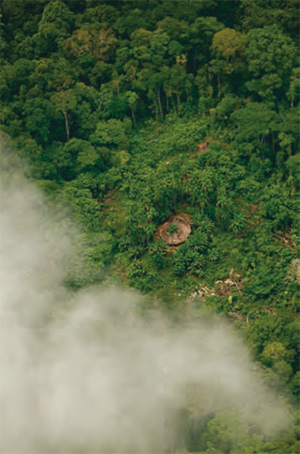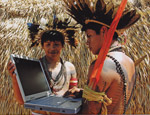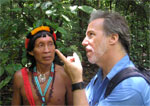Overflights of remote Colombian rainforest yield first photographic evidence of two uncontacted tribes.
Aerial surveys of a remote area of rainforest along the Colombia-Brazil border have produced the first photographic evidence of uncontacted tribes, according to a conservation group that works to safeguard indigenous territories and culture.
The photos, released by the Amazon Conservation Team (ACT) in conjunction with the Colombian National Park Service, show five long houses or malokas thought to belong to two indigenous groups, the Yuri or Carabayo and Passé, some of the last isolated tribes in the Colombian Amazon. The images provide confirmation that uncontacted communities still exist within the Rio Puré National Park, which protects a million hectares (2.47 million acres) of mostly pristine rainforest between the Caquetá and Putumayo River basins along the Brazilian border.
“Although the Park’s objective is to provide shelter for this indigenous group, anthropological data was needed to inform the formulation of official governmental legislation and policies to safeguard both the integrity of the region and the survival of this group,” said Liliana Madrigal, co-founder of ACT, speaking to mongabay.com on the sidelines of the Skoll World Forum for Social Entrepreneurship in Oxford late last month.
 Photo by Cristóbal von Rothkirch, courtesy of Colombian National Parks Unit and Amazon Conservation Team. |
The aerial reconnaissance was done in partnership with the Colombian National Park Service after analysis of vegetation data from satellite imagery. The research was led by ACT political scientist Roberto Franco, who says uncontacted members of a third tribe — the Jumana — also likely live in the park.
The findings are significant because isolated and uncontacted indigenous people in the Colombian are afforded the right to isolation, the right to their traditional territories, and reparations in case of violence under legal decree #4633 signed by Colombian President Santos in December 2011. That measure specifically protects such groups — which may be voluntarily isolated — from unwanted contact:
-
The State shall guarantee the rights of uncontacted indigenous peoples or indigenous peoples in voluntary isolation to remain in that condition and live freely according to their cultures on their ancestral lands. Therefore, as subjects of special protection, under no circumstances may they be stripped of their territories, or be subject to policies, programs or activities, private or public, that promote contact or realize interventions in their territories for any purpose.
 Photo by Cristóbal von Rothkirch, courtesy of Colombian National Parks Unit and Amazon Conservation Team. |
The decree was passed following guidelines developed by a committee that involved the Colombian National Park Service, the Ministry of the Interior and Justice, the Ministry of Culture, the Instituto Colombia de Antropología e Historia, ACT, Conservation International, and the Fundacion Gaia Amazonas.
Now that isolated tribes have been identified in the park, the authorities working with ACT and others will attempt to define their territories in order to develop zoning and management plans that will protect them from encroachment and land invasions. The park lies in an area that is vulnerable to illegal logging, mining, and drug trafficking. Any contact from outsiders —whether traffickers, loggers, miners, farmers, or tourists — could put isolated rainforest people at great risk due from disease.
“The risk arising from incursions into their territories is contact that transmits diseases to which isolated people have no resistance,” Roberto Franco told mongabay.com via email. “The second risk is violence against isolated tribe members.”
First contact can decimate isolated communities. For example, after initial contact in 2003, more than half the Nukak Maku tribe — who live in the Colombian department of Guaviare — died from disease. A handful of Nukak Maku family groups may remain uncontacted.
Franco says the size of the uncontacted Yuri and Passé communities is unknown, but could be on the order of 300-500 people.
“If there are 4 groups in the area this would be roughly 1200 and 2000 people,” he wrote.
The history of the Yuri tribe is explored in Cariba malo, a book published this year by the Colombian National University, the Colombian National Park Service and ACT-Colombia. The book details “episodes of contact and resistance” over a 400-year period, including the retreat of communities into voluntary isolation following bloody conflict with rubber tappers and slavers.
While risks remain for these isolated groups, Colombia’s constitution — thanks to hard-fought political battles waged by indigenous leaders and their advocates like Martín von Hildebrand of Fundacion Gaia Amazonas — grants an unusually high degree of protection to native communities. Communities today can establish their local governance systems, which enables them to manage their own education and health programs.
ACT’s Franco says that more work needs to be done to ensure that the uncontacted groups’ rights are respected and their needs met should any communities decide to end their isolation.
“There needs to be a contingency plan with the Ministry of Health and the Colombian Institute of Anthropology and History in case they are contacted or themselves seek contact.”
Carolina Gil, program director for ACT-Colombia, echoes this view.
“It is necessary to simultaneously strengthen the rights of these peoples in their decision to remain isolated and draw the attention of the competent institutions to take necessary measures for their protection, which also benefits the conservation of strategic ecosystems.”
Related articles
Isolated indigenous people and tourists collide in Peru park
(10/19/2011) New video released by the Peruvian government shows a potentially disastrous encounter between tourists and indigenous people long isolated from the outside world. In a motor boat tourists follow a group of Mashco-Piro people walking along the shores of the Manu River in Manu National Park. At one point one of the tribal members prepares to fire at the boat with an arrow. But danger doesn’t only come from the possibility of a violent clash: uncontacted indigenous people, those who have chosen isolation from the world, are incredibly susceptible to disease.
Brazil confirms existence of new uncontacted Amazon tribe
(06/22/2011) The Brazilian government confirmed the existence of a community of uncontacted Amerindians in a protected area near the Peruvian border, reports Funai, Brazil’s Indian affairs agency.
NGO warns oil exploration in Peru may ‘decimate’ uncontacted tribes
(10/17/2010) Survival International has warned that oil exploration in northern Peru threatens two uncontacted tribes. The organization, devoted to indigenous rights, has sent a letter to the UN’s Special Rapporteur on indigenous peoples, James Anaya, alleging that Peru is “violating international law” by allowing oil companies to explore a region home to uncontacted people, who are especially vulnerable to disease.
Taking back the rainforest: Indians in Colombia govern 100,000 square miles of territory

(05/10/2010) Indigenous groups in the Colombian Amazon have long suffered deprivations at the hands of outsiders. First came the diseases brought by the European Conquest, then came abuses under colonial rule. In modern times, some Amazonian communities were virtually enslaved by the debt-bondage system run by rubber traders: Indians could work their entire lives without ever escaping the cycle of debt. Later, periodic invasions by gold miners, oil companies, colonists, and illegal coca-growers took a heavy toll on remaining indigenous populations. Without title to their land, organization, or representation, indigenous Colombians in the Amazon seemed destined to be exploited and abused. But new hope would emerge in the 1980s, thanks partly to the efforts of Martin von Hildebrand, an ethnologist who would help indigenous Colombians eventually win control over 260,000 square kilometers (100,000 square miles) of Amazon rainforest—an area larger than the United Kingdom.

(11/29/2009) A new handbook lays out the methodology for cultural mapping, providing indigenous groups with a powerful tool for defending their land and culture, while enabling them to benefit from some 21st century advancements. Cultural mapping may also facilitate indigenous efforts to win recognition and compensation under a proposed scheme to mitigate climate change through forest conservation. The scheme—known as REDD for reducing emissions from deforestation and degradation—will be a central topic of discussion at next month’s climate talks in Copenhagen, but concerns remain that it could fail to deliver benefits to forest dwellers.
Indians are key to rainforest conservation efforts says renowned ethnobotanist

(10/31/2006) Tropical rainforests house hundreds of thousands of species of plants, many of which hold promise for their compounds which can be used to ward off pests and fight human disease. No one understands the secrets of these plants better than indigenous shamans -medicine men and women – who have developed boundless knowledge of this library of flora for curing everything from foot rot to diabetes. But like the forests themselves, the knowledge of these botanical wizards is fast-disappearing due to deforestation and profound cultural transformation among younger generations. The combined loss of this knowledge and these forests irreplaceably impoverishes the world of cultural and biological diversity. Dr. Mark Plotkin, President of the non-profit Amazon conservation Team, is working to stop this fate by partnering with indigenous people to conserve biodiversity, health, and culture in South American rainforests. Plotkin, a renowned ethnobotanist and accomplished author (Tales of a Shaman’s Apprentice, Medicine Quest) who was named one of Time Magazine’s environmental “Hero for the Planet,” has spent parts of the past 25 years living and working with shamans in Latin America. Through his experiences, Plotkin has concluded that conservation and the well-being of indigenous people are intrinsically linked — in forests inhabited by indigenous populations, you can’t have one without the other. Plotkin believes that existing conservation initiatives would be better-served by having more integration between indigenous populations and other forest preservation efforts.